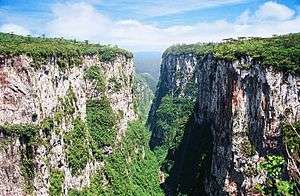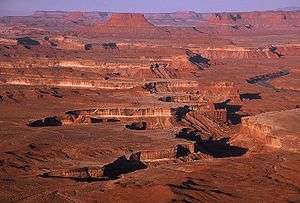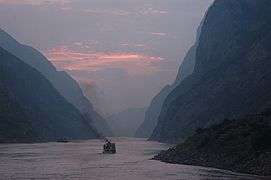Canyon

A canyon (Spanish: cañón; archaic British English spelling: cañon[1]) or gorge is a deep cleft between escarpments or cliffs resulting from weathering and the erosive activity of a river over geologic timescales. Rivers have a natural tendency to cut through underlying surfaces, eventually wearing away rock layers as sediments are removed downstream. A river bed will gradually reach a baseline elevation, which is the same elevation as the body of water into which the river drains. The processes of weathering and erosion will form canyons when the river's headwaters and estuary are at significantly different elevations,[2] particularly through regions where softer rock layers are intermingled with harder layers more resistant to weathering.
A canyon may also refer to a rift between two mountain peaks, such as those in ranges including the Rocky Mountains, the Alps, the Himalayas or the Andes. Usually a river or stream and erosion carve out such splits between mountains. Examples of mountain-type canyons are Provo Canyon in Utah or Yosemite Valley in California's Sierra Nevada. Canyons within mountains, or gorges that have an opening on only one side, are called box canyons. Slot canyons are very narrow canyons that often have smooth walls.
Steep-sided valleys in the seabed of the continental slope are referred to as submarine canyons. Unlike canyons on land, submarine canyons are thought to be formed by turbidity currents and landslides.
Etymology

The word canyon is Spanish in origin (cañón,[3] pronounced [kaˈɲon]), with the same meaning. The word canyon is generally used in North America while the words gorge and ravine are used in Europe and Oceania, though gorge and ravine are also used in some parts of North America. In the United States, place names generally use canyon in the southwest and gorge in the northeast, with the rest of the country graduating between these two according to geography. In Canada, a gorge is usually narrow while a ravine is more open and often wooded. The military-derived word defile is occasionally used in the United Kingdom.
Formation
Most canyons were formed by a process of long-time erosion from a plateau or table-land level. The cliffs form because harder rock strata that are resistant to erosion and weathering remain exposed on the valley walls.
Canyons are much more common in arid than in wet areas because physical weathering has a more localized effect in arid zones. The wind and water from the river combine to erode and cut away less resistant materials such as shales. The freezing and expansion of water also serves to help form canyons. Water seeps into cracks between the rocks and freezes, pushing the rocks apart and eventually causing large chunks to break off the canyon walls, in a process known as frost wedging.[4] Canyon walls are often formed of resistant sandstones or granite.
Sometimes large rivers run through canyons as the result of gradual geological uplift. These are called entrenched rivers, because they are unable to easily alter their course. In the United States, the Colorado River in the Southwest and the Snake River in the Northwest are two examples of tectonic uplift.
Canyons often form in areas of limestone rock. As limestone is soluble to a certain extent, cave systems form in the rock. When these collapse, a canyon is left, as in the Mendip Hills in Somerset and Yorkshire Dales in Yorkshire, England.
Box canyon
A box canyon is a small canyon that is generally shorter and more narrow than a river canyon, with steep walls on three sides, allowing access and egress only through the mouth of the canyon. Box canyons were frequently used in the western United States as convenient corrals, with their entrances fenced.[5]
Largest canyons
The definition of "largest canyon" is imprecise, because a canyon can be large by its depth, its length, or the total area of the canyon system. Also, the inaccessibility of the major canyons in the Himalaya contributes to their not being regarded as candidates for the biggest canyon. The definition of "deepest canyon" is similarly imprecise, especially if one includes mountain canyons as well as canyons cut through relatively flat plateaus (which have a somewhat well-defined rim elevation).

The deepest canyon in the world is at the confluence of the Gilgit and Indus rivers, where the Karakoram Highway was constructed; the river flows at an elevation of about 1,000 m (3,300 ft) above sea level. To the south by 15 km, rising in one continuous sweep above the Indus, the world's largest such rise is the summit of the world's ninth-highest mountain, Nanga Parbat, 8,126 m (26,660 ft) high. Rising to the north, also visible from the bridge over the Gilgit, is the westernmost of the great Himalayan peaks, Rakaposhi, 7,788 m (25,550 ft) high. That makes the Indus gorge 7,120 m (23,360 ft) deep from river to peak at that point, more than 600 m (2,000 ft) greater than the depth of the Kali Gandaki Gorge and 1,500 m (5,000 ft) deeper than the Yarlung Tsangpo Gorge. These are the three deepest canyons in the world. Only the largest mountain ranges of Asia have the scale for such canyons to have formed. The Andes of South America are high mountains, but not on the same scale as the Himalayas, Karakoram, or Hindu Kush, which all come together at the confluence of the Gilgit and the Indus in Pakistani Kashmir.
The Yarlung Tsangpo Grand Canyon (or Tsangpo Canyon), along the Yarlung Tsangpo River in Tibet, is regarded by some as the deepest canyon in the world at 5,500 m (18,000 ft). It is slightly longer than the Grand Canyon in the United States.[6] Others consider the Kali Gandaki Gorge in midwest Nepal to be the deepest canyon, with a 6400 m (21,000 ft) difference between the level of the river and the peaks surrounding it.
Vying for deepest canyon in the Americas are the Cotahuasi Canyon and Colca Canyon, in southern Peru. Both have been measured at over 3500 m (12,000 ft) deep.
The Grand Canyon of northern Arizona in the United States, with an average depth of 1,600 m (one mile) and a volume of 4.17 trillion cubic metres,[7] is one of the world's largest canyons. It was among the 28 finalists of the New7Wonders of Nature worldwide poll. (Some referred to it as one of the 7 natural wonders of the world.[8]) Copper Canyon in Chihuahua, Mexico is deeper and longer than the Grand Canyon.
The largest canyon in Africa is the Fish River Canyon in Namibia.[9]
In August 2013, the discovery of Greenland's Grand Canyon was reported. Located under an ice sheet, based on the analysis of date from Operation IceBridge. At 750 kilometres (466 mi) long, it is believed to be the longest canyon in the world.[10]
The Capertee Valley in Australia is commonly reported as being the second largest (in terms of width) of any canyon in the world.[11][12]
Cultural significance
Some canyons have notable cultural significance. Evidence of early humanoids has been discovered in Africa's Olduvai Gorge. In the southwestern United States, canyons are important archeologically because of the many cliff-dwellings built in such areas, largely by the ancient Pueblo people who were their first inhabitants.
Notable examples
The following list includes only the most notable canyons of the world, arranged by continent and then country.
Africa

South Africa
Namibia
Tanzania
Americas
Argentina
Brazil

Canada
- Grand Canyon of the Stikine, British Columbia
- Horseshoe Canyon, Alberta
- Niagara Gorge, Ontario
- Ouimet Canyon, Ontario
Mexico
Peru
- Colca Canyon, Arequipa
- Cotahuasi Canyon, Arequipa
United States

- Antelope Canyon, Arizona
- Black Canyon of the Gunnison, Colorado
- Canyon de Chelly, Arizona
- Canyonlands National Park, canyons of the Colorado River and its main tributary the Green River, Utah
- Columbia River Gorge, Washington and Oregon
- Glen Canyon, Utah and Arizona
- Glenwood Canyon, Colorado
- Grand Canyon, Arizona
- Grand Canyon of the Yellowstone, Wyoming
- Palo Duro Canyon, Texas
- Rio Grande Gorge, New Mexico
- Waimea Canyon, Hawaii
- Zion Canyon, Utah
Asia

India
China
- Three Gorges, Chongqing
- Tiger Leaping Gorge, Yunnan
- Yarlung Zangbo Grand Canyon, Tibet Autonomous Region
Others
- Kazakhstan—Charyn Canyon
- Nepal—Kali Gandaki Gorge
- Pakistan—Indus River Gorge through the Himalaya
Europe
England

France
- Ardèche Gorges, Rhône-Alpes
- Daluis Gorge, Provence
- Gorges du Tarn
- Verdon Gorge, Alpes-de-Haute-Provence
Others

- Greece—Vikos Gorge
- Greenland—Greenland's Grand Canyon
- Iceland—Fjaðrárgljúfur Canyon
- Macedonia—Matka Canyon
- Montenegro—Tara River Canyon
- Norway—Sautso Canyon
- Poland/Slovakia—Dunajec River Gorge
- Serbia—Rugova Canyon
- Switzerland—Aare Gorge
Oceania
Australia

- Joffre Gorge, Karijini National Park, Western Australia
- Katherine Gorge, Northern Territory
- Kings Canyon, Northern Territory
- Murchison River Gorge, Western Australia
New Zealand
- Manawatu Gorge, North Island
- Skippers Canyon, South Island
Canyons on other planetary bodies
- Ithaca Chasma on Saturn's moon Tethys
- Valles Marineris on Mars, the largest known canyon in the solar system
- Vid Flumina on Saturn's largest moon Titan is the only known liquid-floored canyon in the solar system besides Earth[13]
Venus has many craters and canyons on its surface. The troughs on the planet are part of a system of canyons that is more than 6 400 km long.
See also
References
- ↑ "canon".
archaic spelling of canyon
- ↑ Ward Cameron. "Understanding Canyon Formation".
- ↑
 Chisholm, Hugh, ed. (1911). "Canyon". Encyclopædia Britannica (11th ed.). Cambridge University Press.
Chisholm, Hugh, ed. (1911). "Canyon". Encyclopædia Britannica (11th ed.). Cambridge University Press. - ↑ "The Geology of the Grand Canyon". Retrieved 2015-10-01.
- ↑ "box canyon". Encarta World English Dictionary. 2009. Archived from the original on 2009-10-31. Retrieved 2009-08-04.
- ↑ "China Virtual Museums: Canyon". Kepu.net.
- ↑ "Park Statistics". National Park Service. USA.
- ↑ Truong, Alice (1 July 2011). "Everything About the Grand Canyon". Discovery Communications. Retrieved 5 February 2012.
- ↑ Cohen, Callan; Spottiswoode, Claire & Rossouw, Jonathan (2006). Southern African Birdfinder. p. 210. ISBN 1-86872-725-4.
- ↑ "Grand Canyon of Greenland Discovered under Ice". news.discovery.com.
- ↑ Fitzsimons, David (14 December 2015). "Capertee Valley: Australia's own Grand Canyon". Daily Telegraph. Retrieved March 28, 2016.
- ↑ Kruszelnicki, Dr. Karl S. (22 May 2012). "Grand Canyon is not so grand › Dr Karl's Great Moments In Science". ABC Science. Retrieved March 28, 2016.
- ↑ Valerio Poggiali, Marco Mastrogiuseppe, Alexander G. Hayes, Roberto Seu, Samuel P. D. Birch, Ralph Lorenz, Cyril Grima, Jason D. Hofgartner, "Liquid-filled Canyons on Titan", 9 August 2016, http://onlinelibrary.wiley.com/doi/10.1002/2016GL069679/abstract
External links
| Look up canyon in Wiktionary, the free dictionary. |
![]() Media related to Canyons at Wikimedia Commons
Media related to Canyons at Wikimedia Commons

